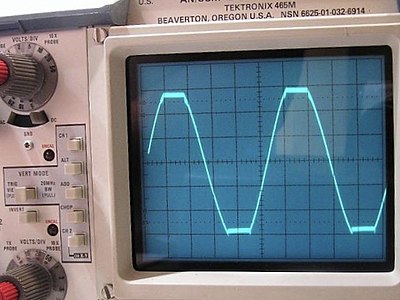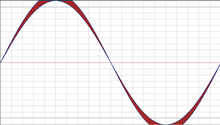| Mister Deejay :: Forumi :: ::Main Floor Oddelek:: :: DJ |
|
<< Prejšna tema | Naslednja tema >> |
| Kaj pomeni RMS/MUSIC/PEAK? | ||
| Pojdi na stran << | |
|
Moderatorji: Admin, David
|
| Avtor | Tema | ||
| Mihael |
| ||
![[ Član ]](../../e107_images/rate/lite/lev2.png) Registriran član #6797 Pridružen: sep 15 2010, 08:06Lokacija: Slovenska Bistrica Sporočila: 38 | Clip je popačen signal. Ko pri sinusnem (izmeničnem) signalu začne rezat špice in počasi prehaja v enosmerno napetost. To pa pomeni...smrt zvočnikom. Tega se je zelo dobro treba izogibat, tako na zvočnikih kot na ojačevalcu. ko ti zagori rdeča lučka, veš, da moraš zmanjšat, sicer pride do popačenja in potem... Če sem kaj izpustil, me naj Zvone popravi. | ||
| Nazaj na vrh | | ||
| kristjan |
| ||
![[ Stotnik ]](../../e107_images/rate/lite/lev3.png) Registriran član #6790 Pridružen: sep 11 2010, 20:20Sporočila: 59 | aja clip je ubistvu hreščanje, pač preobremenitev zvočnika ok razumem zdej hvala a sm prou razumu? :-D | ||
| Nazaj na vrh | | ||
| David |
| ||
Mister DJ, D@D ![[ Šef ]](../../e107_images/rate/lite/lev6.png) Registriran član #95 Pridružen: jul 27 2003, 15:45Sporočila: 549 | From Wikipedia, the free encyclopedia For shortening of voice snippets due to failures in voice activity detection, see squelch and voice activity detection. Clipping is a form of waveform distortion that occurs when an amplifier is overdriven and attempts to deliver an output voltage or current beyond its maximum capability. Driving an amplifier into clipping may cause it to output power in excess of its published ratings.
[edit]Overview of clippingWhen an amplifier is pushed to create a signal with more power than its power supply can produce, it will amplify the signal only up to its maximum capacity, at which point the signal can be amplified no further. As the signal simply "cuts" or "clips" at the maximum capacity of the amplifier, the signal is said to be "clipping". The extra signal which is beyond the capability of the amplifier is simply cut off, resulting in a sine wave becoming a distorted square-wave-type waveform. Many electric guitar players intentionally overdrive their guitar amplifiers to cause clipping in order to get a desired sound (see guitar distortion). Amplifiers have voltage, current and thermal limits. Clipping may occur due to limitations in the power supply or the output stage. Some amplifiers are able to deliver peak power without clipping for short durations before energy stored in the power supply is depleted or the amplifier begins to overheat. Amplifier power ratings are typically established by driving the device-under-test to the onset of clipping, to a predetermined distortion level, variable per manufacturer or per product line. Driving an amplifier to 1% distortion levels will yield a higher rating than driving it to 0.01% distortion levels.[1] Similarly, testing an amplifier at a single mid-range frequency, or testing just one of two channels, will yield a higher rating than if it is tested throughout its intended frequency range with both channels working. Manufacturers may use these methods to market amplifiers whose published maximum power output includes some amount of clipping in order to show higher numbers.[1] For instance, the Federal Trade Commission (FTC) established an amplifier rating system in which the device is tested with both channels driven throughout its advertised frequency range, at no more than its published distortion level. The Electronic Industries Association (EIA) rating system, however, determines amplifier power by measuring a single channel at 1,000 Hz, with a 1% distortion level—1% clipping. Using the EIA method rates an amplifier 10 to 20% higher than the FTC method, at the cost of audio fidelity.[1] [edit]Effects of clippingIn power amplifiers, the signal from an amplifier operating in clipping has two characteristics that could damage a connected loudspeaker:
Other effects of clipping include:
[edit]Digital clippingMain article: saturation arithmetic In digital signal processing, clipping occurs when the signal is restricted by the range of a chosen representation. For example in a system using 16-bit signed integers, 32767 is the largest positive value that can be represented, and if during processing the amplitude of the signal is doubled, sample values of, for instance, 32000 should become 64000, but instead they are truncated to the maximum, 32767. Clipping is preferable to the alternative in digital systems—wrapping—which occurs if the digital hardware is allowed to "overflow", ignoring the most significant bits of the magnitude, and sometimes even the sign of the sample value, resulting in gross distortion of the signal. [edit]Avoiding clippingAs seen on the oscilloscope, the wave resulting from the clipping is not a full sine wave. To avoid this, the overall level of a mix can be lowered, or a limiter can be used to dynamically bring the levels of the loud parts down (for example, bass and snare drums). It is not simple to eliminate all clipping, as filtering (e.g. a high-pass filter) can align various frequencies in such a way as to create excessive peak outputs. The excessive peaks may become clipped even though the amplifier can play any single sine wave without clipping. As such, some audiophiles will use amplifiers that are rated for power outputs over twice the speaker's ratings. [edit]Repairing a clipped signalComplex hard-clipped signals (recorded at CD resolution or less) cannot be restored to their original state because the information contained in the peaks that are clipped is completely eliminated. Soft-clipped signals can be restored to their original state to within a case-dependent tolerance because no part of the original signal is completely eliminated. In this case, the degree of information loss is proportional to the degree of compression caused by the clipping. Lightly clipped bandwidth-limited signals that are highly oversampled have a high likelihood of perfect repair.[2] It is preferable to avoid clipping, but if a recording has clipped, and cannot be re-recorded, repair is an option. The goal of repair is to make up a plausible replacement for the clipped part of the signal. Several methods can partially restore a clipped signal. Once the clipped portion is known, one can attempt partial recovery. One such method is interpolation or extrapolation of known samples. While this is only an approximation of the original, the subjective quality is usually improved, sometimes with no audible difference.[citation needed] Other methods may also be used. One of the methods in CuteStudio Declip, for example, works by copying the signal directly from one stereo channel to another, as it may be the case that only one channel is clipped. Several software solutions of varying results and methods exist to counteract this problem: Sony Sound Forge, Adobe Audition, Nero Wave Editor, and a plugin in the Audacity LADSPA package come with clip restoration software. There is also an Audacity plugin called Clip Fix that uses cubic splines to attempt to restore a continuously differentiable signal. [edit]Sources of clippingIn analog audio equipment, there are several causes of clipping:
Več: http://en.wikipedia.org/wiki/Clipping_(audio) [ Urejeno dec 22 2010, 22:48 ] | ||
| Nazaj na vrh | | ||
| Mihael |
| ||
![[ Član ]](../../e107_images/rate/lite/lev2.png) Registriran član #6797 Pridružen: sep 15 2010, 08:06Lokacija: Slovenska Bistrica Sporočila: 38 | Clip zvočnika pomeni, kadar zvočnik več nemore oddajati čisti signal, torej je že v popačenju. Clip ojačevalca pomeni, kadar ojačevalec več nemore oddajati čist signal (sinus). Ni fajn, če je zvočnik ali ojačevalec v clipu. Samo tega se izogibaj. | ||
| Nazaj na vrh | | ||
| zvone |
| ||
![[ Stotnik ]](../../e107_images/rate/lite/lev3.png) Registriran član #1659 Pridružen: dec 22 2004, 12:22Sporočila: 747 | Zvočnik nikoli in še takrat ne more biti v clip-u.To se zgodi samo v ojačevalcu,ko zaradi nesorazmerij signala na vhodu in izhodu pride do spremembe sinusnega signala v žagastega ali še huje v pravokotnega.Tak signal začne pregrevati navitje zvočnika tako dolgo,dokler ne doseže tako visoke temperature(do500 stopinj) ,da se ovoji žice razširijo,izstopijo iz svoje forme,kjer jih zagrabi rob magneta in......sivi dim-najprej iz zvočnika,natopa črni dim iz ojačevalca......Tako lahko ojačevalec z močjo10W po kanalu v clip-u z lahkoto "zakuri" 500W zvočnik.Prižigajoča clip dioda na ojačevalcu opozarja ,da se bliža brezizhodna smrt zvočnika-zato jo je treba vzeti skrajno resno in zmanjšati glasnost ojačevalca ali pa uporabiti kompresor. Poznam pa tudi tonskega tehnika (s Štuka) ,ki pravi,da ,ko ima liter vodke v riti ne j..e nobene lučke več....-bistro! | ||
| Nazaj na vrh | | ||
| Pojdi na stran << | |



















 Vse pravice pridržane! ISSN 1855-9786
Vse pravice pridržane! ISSN 1855-9786